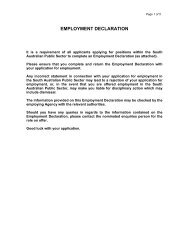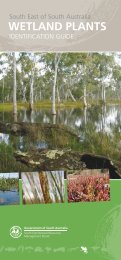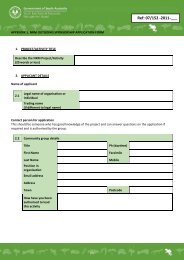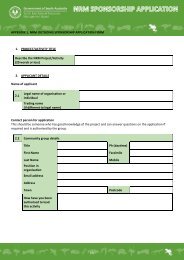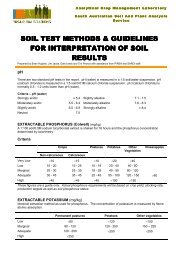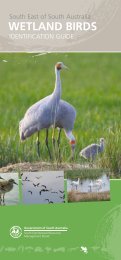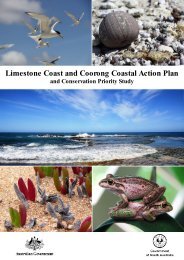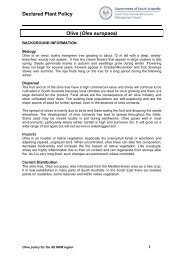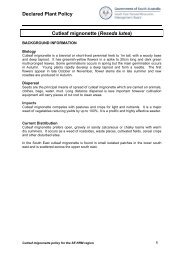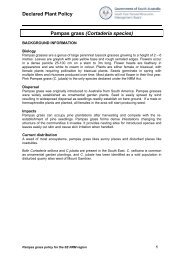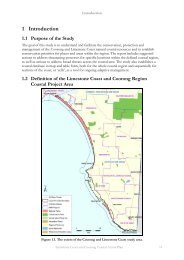Cell Descriptions - South East Natural Resources Management Board
Cell Descriptions - South East Natural Resources Management Board
Cell Descriptions - South East Natural Resources Management Board
Create successful ePaper yourself
Turn your PDF publications into a flip-book with our unique Google optimized e-Paper software.
SE11 – Guichen Bay<br />
Sea Eagle (Haliaeetus leucogaster), <strong>East</strong>ern Osprey (Pandion cristatus), and Little (Sternula albifrons) and<br />
Fairy (Sternula nereis) Terns.<br />
Benthic Habitat<br />
Inshore bare sand runs out to low profile reef some 300 to 600m into Guichen Bay. A large<br />
patch of bare sand off Robe encloses a number of areas of heavy limestone reef.<br />
Land Use/ Land Ownership<br />
Predominantly grazing land use throughout. Guichen Bay CP lies adjacent to the coast (acquired<br />
1967, see 'Small Coastal Parks <strong>Management</strong> Plan', 1994) and has no road access. It protects only<br />
127 ha of the vegetated dune ridges that are the dominant feature of the cell as described above.<br />
Upper <strong>South</strong> <strong>East</strong> Marine Park (Boatswains Point to Nora Creina) extends the length of the cell.<br />
Robe lakes and connecting Drain L are dedicated Crown land to the <strong>South</strong> <strong>East</strong> Water<br />
Conservation and Drainage <strong>Board</strong>. The Long Beach residential part of Robe is nestled in the<br />
southern corner of the cell, separated from the main township by the lakes and drain. <strong>South</strong> of<br />
the CP, a narrow unallotted Crown land reserve extends around Guichen Bay and connects to a<br />
Crown land reserve at the Robe end of Long Beach which is in the care and control of Council.<br />
Values/ Uses (Field visits and local reports)<br />
Long Beach is heavily utilised for recreation and is a highly travelled stretch of beach by vehicles.<br />
Majority of the cell is used for grazing and cropping. Aboriginal Heritage values throughout.<br />
Threats (Field visits and local reports)<br />
Remnant coastal vegetation and the conservation park are threatened by pest plant and animal<br />
incursion from adjacent primary production land. Inappropriate Primary Industry and Residential<br />
(Coastal)(Frenchman Bay) development plan zoning of the foredune ridges. Native vegetation<br />
around the Robe Lakes and Beacon Hill seriously threatened by weed invasion.<br />
Opportunities<br />
Development of a strategy to preserve a transect across the time series geological record of beach<br />
ridges, from the coast to the Woakwine Range.<br />
(The following is an extract from Slater and Farrington 2010) “There are historic records of<br />
<strong>South</strong>ern Bell Frog in Drain L, which crosses <strong>Cell</strong> SE11 to the Robe lakes and then Guichen Bay.<br />
Anecdotal reports from local landowners suggest the species may still be present in the area. A<br />
detailed frog survey should be carried out of these drains to assess if the <strong>South</strong>ern Bell Frog is<br />
still present (this should involve a minimum of three site visits and the use of frog recording<br />
devices). Recent surveys have recorded <strong>South</strong>ern Pygmy Perch from this site (Hammer, 2009).<br />
The connectivity of the site to Reedy Creek Wilmot Drain suggests that Dwarf Galaxias would<br />
still be present in Drain L and K albeit in low numbers. However, this would need to be<br />
confirmed via more thorough survey effort. In addition, a detailed survey of Drain L and K for<br />
fish and amphibians is required to identify key refuge areas or sites that could be suitable refuge<br />
creation.”<br />
Conservation Analysis (GIS)<br />
The sum of conservation means for Guichen Bay is low within the region, 84.82. The bulk of the<br />
cell is taken up with cleared and grazed dune ridges of low conservation value, with only the<br />
uncleared foredunes showing moderate to high conservation values; a further kilometre from the<br />
shore, some partially cleared land has moderate totals. This pattern is reflected in the Guichen<br />
Bay CP, which was grazed until 1967. However, the detail shows there are a number of state rare<br />
Leucopogon shrubland associations within the dunes, also there are extensive areas of habitat<br />
suitable for the Orange Bellied Parrot in this part of the cell.<br />
Limestone Coast and Coorong Coastal Action Plan 403



